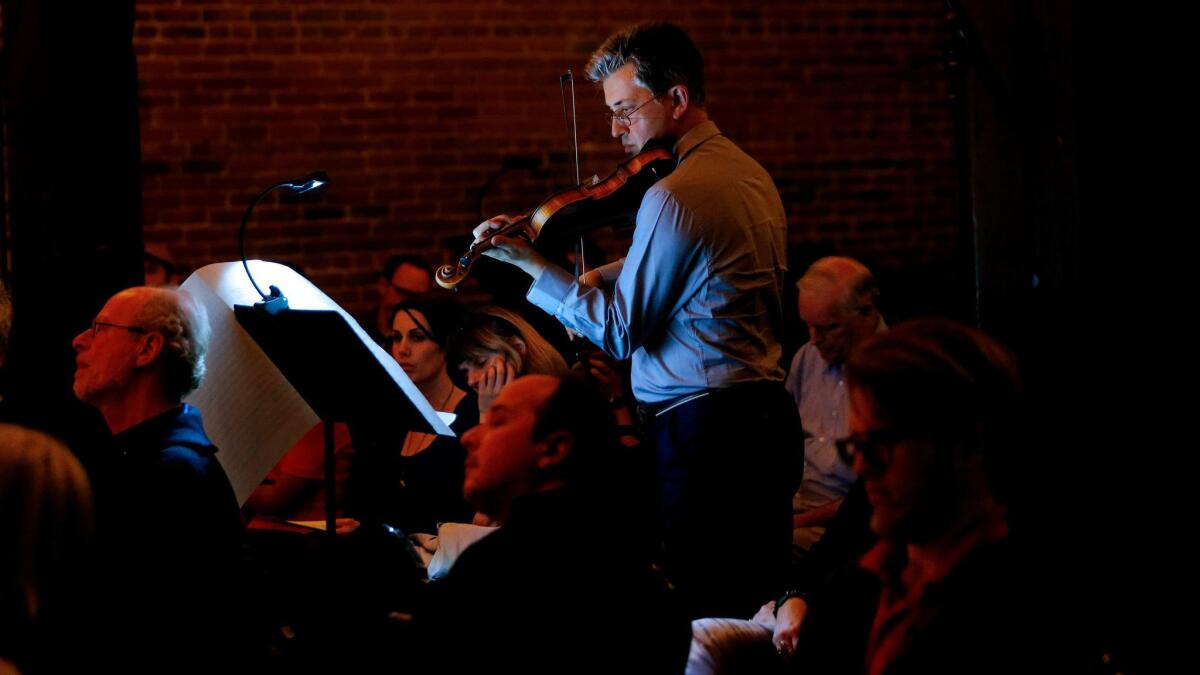Review: With violin in hand, Mark Menzies finds hope for the future in the past

- Share via
Music, we all know, can change moods. But can it change minds as well? Just how crazy is it to expect a single violin to coax us toward utopia?
That is the mission of Luigi Nono’s 45-minute masterpiece, “La Lontananza Nostalgica Utopica Futura: Madrigale per piu ‘Caminantes’ con Gidon Kremer.” The work for solo violin, eight channels of violin-irradiated electronic music and, importantly, eight to 10 music stands was given a rare and wonderfully convincing performance by Mark Menzies on Friday night at Art Share L.A. downtown.
There is a lot to unpack here. “La Lontananza” was written in 1989, the year before the avant-garde Italian composer died. Also dying at the time was communism, a movement to which the politically intent Nono was devoted. “Nostalgic Distant Utopian Future” suggests that through distance the hope of the future might be found in the past, or something like that. Nono then calls the score a madrigal for many “travelers” with Gidon Kremer.
Kremer was the violinist not only for whom “La Lontananza” was written but with whose sound the piece is infused. Nono devised the eight-channel tape, operated live during performances, from recordings he made of Kremer improvising. The actual score leaves room for a soloist to find his or her own solutions, which means that each new violinist who takes on “La Lontananza” offers a new utopian vision applied to what went before in Kremer’s.

The music stands are spread around the performance space, and the violinist moves from one to the next. Six of the stands hold the music for the six sections of the work. The additional two to four have dummy scores. The performer’s journey is not linear. Menzies lingered between sections. He zigzagged around the space, sometimes stopping at the dummy stands before reaching his destination. No one said Utopia is just around the corner.
The music itself is like an anatomical, physiological and spiritual examination of the violin: what the instrument can do and what it can do to a listener. An imaginative virtuoso is required. The dynamic range is from what is only audible to a dog to the loudest sounds the instrument can humanly make. Everything Nono could think of doing to a violin with a bow, he has the violinist do.
The result is complex and ever changing. There can be the effect of a sweet singing voice and the effect of horror. Pitches that are familiar contend with microtones that are not. The violin is caressed and attacked with every inch of the bow. Parts of the score are skittish. The second section ended with crunching effects.
For the third, Menzies stood directly behind me, playing ghostly calm drones of sustained harmonics that felt as they entered the mind as vibrations bypassing ear and auditory nerve. The room itself was suffused by waves of wondrous violin effects on the surround-sound loudspeakers. Rather than rely on the banality of virtual reality, Menzies and Nono produced virtual unreality, the feeling of levitation.
What is past and what is future, what is utopian and what is dystopian in this political theater of the violin and of the mind? Nono doesn’t provide the answers. He shows us not where to go but how to go. Instead of being a destination, utopia is a process of opening up to experiencing the unfamiliar.
As to whether music can change minds, it can. John Cage happened to be at the London premiere of “La Lontananza” in 1990. Three decades earlier he had had a falling out with Nono, but Cage (who famously disavowed music as emotional expression) said after the London concert, “I no longer hold a grudge against Luigi.”
After 17 years on the faculty of CalArts and a mainstay in the L.A. new music scene, Menzies has returned to his native New Zealand. But he is back in town celebrating his 47th birthday with the ambitious series “four in the time of seven,” four solo violin and viola recitals of new and old music in seven days.
He had played “La Lontananza” here in 2003 at a Southwest Chamber Music concert. This time it was in collaboration with the new music collective wasteLAnd, and Menzies had the advantage of a room ideally reverberant and flexible. The executive director of wasteLAnd, composer Scott Worthington, handled the electronics with alluring flair.
The program began with two short pieces. Ching-Wen Chao’s robustly enigmatic violin solo “Elegy in Flight,” evoking the Buddhist recitation for the dead, and the premiere of a winningly lyrical viola solo, “Elegy,” written for Menzies by Erik Ulman.
Menzies’ seven-day odyssey takes him to REDCAT Monday for a mixed program of New Zealand, European and American solo pieces and to Monk Space in Koreatown on Tuesday for three of Bach’s solo sonatas and partitas, an early example of the violin’s penchant for utopian thought.
------------
Mark Menzies
When: 8:30 p.m. Monday at REDCAT, 631 W. 2nd St., L.A. Also at 7 p.m. Tuesday at Monk Space, 4414 W. 2nd St., L.A.
Tickets: $10-$20
Info: (213) 237-2800 or www.redcat.org; (213) 925-8562 or www.monkspace.com
More to Read
The biggest entertainment stories
Get our big stories about Hollywood, film, television, music, arts, culture and more right in your inbox as soon as they publish.
You may occasionally receive promotional content from the Los Angeles Times.











